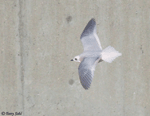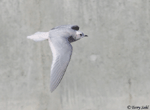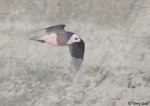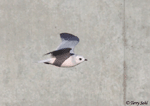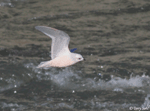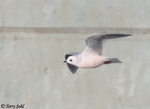| Length: 13-14 inches | Wingspan: 32-34 inches | Seasonality: Extremely Rare Visitor |
| ID Keys: Long wedge-shaped tail, pale overall, dark collar in breeding, white trailing edge on wing | ||
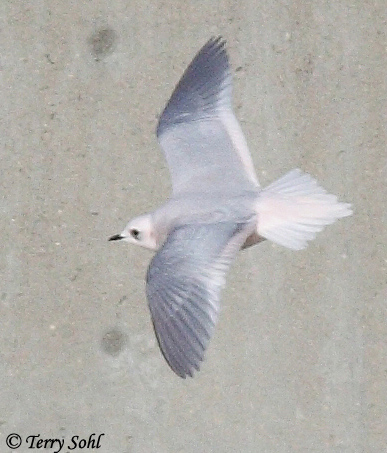 The
Ross's Gull is a small, delicate gull with a rather mythic status among North
American birders. Prior to the 1980s, the only place to reliably try and
see the species in North America was during migration at a few locations in
remote coastal Alaska, as the species typically breeds in Siberia and winters
along the pack ice at sea. However, during the 1980s, Ross's Gulls were found
nesting near Churchill, Manitoba, making the location a prime birding
destination for birders wishing to see the species. The species has
continued to nest near Churchill since the 1980s, and also has been found
nesting in a few locations in remote northern Canada. Ross's Gulls are
only rarely found in the lower 48 states of the United States, with less than 30
records as of 2010. However, November and December, 2010 brought a
relative flurry of records, with 2 birds seen in South Dakota (the first seen in
the state), another near Lincoln, Nebraska, and another in Colorado.
The
Ross's Gull is a small, delicate gull with a rather mythic status among North
American birders. Prior to the 1980s, the only place to reliably try and
see the species in North America was during migration at a few locations in
remote coastal Alaska, as the species typically breeds in Siberia and winters
along the pack ice at sea. However, during the 1980s, Ross's Gulls were found
nesting near Churchill, Manitoba, making the location a prime birding
destination for birders wishing to see the species. The species has
continued to nest near Churchill since the 1980s, and also has been found
nesting in a few locations in remote northern Canada. Ross's Gulls are
only rarely found in the lower 48 states of the United States, with less than 30
records as of 2010. However, November and December, 2010 brought a
relative flurry of records, with 2 birds seen in South Dakota (the first seen in
the state), another near Lincoln, Nebraska, and another in Colorado.
Habitat: During summer breeding season, nests on tundra and marshy bogs. During migration and winter, they are primarily found around pack ice or along northern coasts. Vagrants inland are typically found near large water bodies.
Diet: During migration and in winter, feeds on fish, crustaceans, and mollusks. During the summer breeding season, feeds primarily on insects.
Behavior: Feeds by flying slowly above the water, dropping down to pick food items off of the water's surface, or occasionally performing a shallow dive to grab fish and other prey. Vagrants found in North America often associate with Bonaparte's Gulls.
Breeding Map: Non-breeder in South Dakota.
Song: Vagrants seen in North America are typically quiet, although they will occasionally give a high-pitched mew.
Migration: Primarily breeds in the northern reaches of Siberia. Winters along the pack ice of the Arctic Ocean, with very rare strays further south in winter. Migrating populations are often seen in certain locations in northern Alaska.
Interactive eBird Map: Click here to access an interactive eBird map of Ross's Gull sightings
Similar Species: Somewhat similar to Bonaparte's Gull, although structural and plumage differences are obvious with a good view.
Conservation Status: Global populations are thought to be around 10,000 individuals, but populations appear to be stable. Breeding areas are remote and at little risk from human interference, although climate change could affect habitats in breeding locations in Siberia.
Further Information: 1) BirdWeb.org Ross's Gull
2) Cornell University's "All About Birds - Ross's Gull"
Photo Information: December 1st, 2010 - Gavin's Point Dam, Nebraska/South Dakota border - Terry Sohl
Additional Photos: Click on the image chips or text links below for additional, higher-resolution Ross's Gull photos.
| Click on the map below for a higher-resolution view |
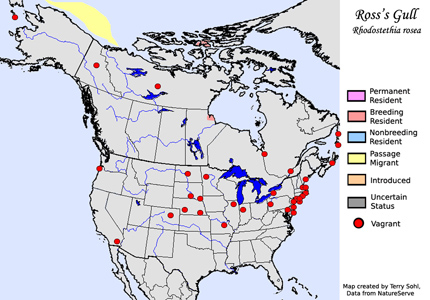 |
| South Dakota Status: To date, there have only a handful of sightings of the species in the state, including the bird pictured above, which visited Gavin's Point Dam in November and December of 2010, and another bird found at the Fort Randall Dam at the same time. |
Additional Ross's Gull Photos
Click for a higher-resolution version of these photos
